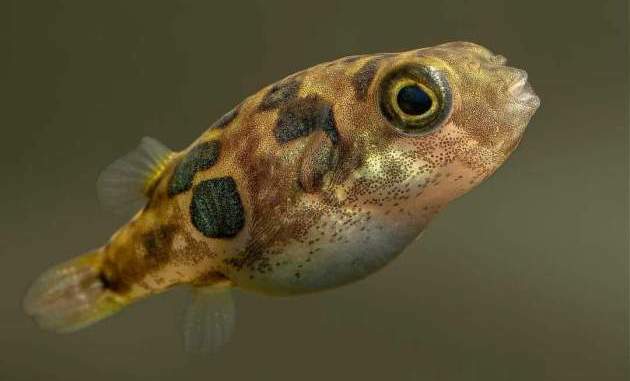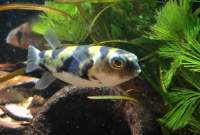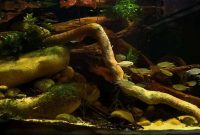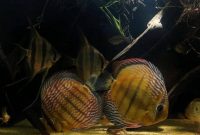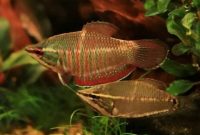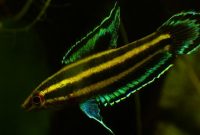“Carinotetraodon Travancoricus” The Smallest Freshwater Puffer Fish – At this moment, we would serve many fun facts about one of an intelligent and clever small freshwater species from India, which is usually called “Pea Puffer Fish.”
This article will share everything you should know about them and how precisely care for this fascinating creature within your tank. Or the best way to start breeding them and any helpful pieces of information for you and your dwarf pufferfish.
Starting from the table of contents, it is perfect for anyone searching for a rapid overview to know if this little fish is suitable for your tank setup. Let’s see it below.
TABLE OF CONTENTS
Dwarf Pea Puffer Fish Care Overview
- Care level: Intermediate
- Minimum tank size: 5-gallon
- Temperament: Territorial and aggressive
- Lifespan: 4-5 Years
- Diet: Carnivore
- Temperature: 77°F – 82°F
- pH: 6.5-8.5
- Size: 1.4 inches (3.5 cm)
- Family: Tetraodontidae
- Common Name: Pygmy Pufferfish, Dwarf Pufferfish, Dwarf Pea Puffer, Pea Puffer Fish, and Malabar Puffer Fish
Species Overview And Origin
Carinotetraodon travancoricus are their scientific name. The pea puffer also has other common names including, Pygmy Pufferfish, Dwarf Pufferfish, Dwarf Pea Puffer, Pea Puffer Fish, and Malabar Puffer Fish.
These little fish are endemic to Kerala and southern Karnataka, India. They usually inhabit many rivers, estuaries, and lakes which various water conditions; the pH range starts from 6.5-8.5 and temperature 77°F-92°F.
Sometimes, the pea puffer is found in the slightly brackish waters. But, never try to keep them in the home aquarium with these environments; it just will decrease their lifespan.
In the summer, their habitat commonly receives sunlight for about 12 hours. And reducing to around 10.5 hours in the winter season. They prefer to spend much time swimming in the slow-moving water streams which plenty of vegetation. In these places, these small freshwater puffer fish do a majority of their hunt projects and breeding.
Unfortunately, due to overfishing, these fish have a decreasing population which caused them to be classification as vulnerable on the IUCN Red List. So, it makes it difficult to see them in their wild habitat. Before purchasing one for yourself, we recommended researching before to ensure the reputation of the fish stores and how they get these fish. Is it from captivity or not?
Generally, the pygmy puffer sells relatively cheap, between $4 or more in trades. You can find them in online marketplaces, but we are advocating to buy in local fish stores so that you can choose the healthier fish.
Read Also: Clea Helena The Assassin Of Aquarium Pest Snails
Dwarf Pea Puffer Fish Appearances
Like their name, these fish have a unique and adorable body form that resembles chunky swimming pea. Based on their size, they are the tiniest species belonging to the Tetraodontidae family. So, that’s why they are also called dwarf pufferfish.
The average size of a fully matured Malabar puffer is about 1.4 inches (3.5 cm); it is clearly not too big with how they earned this nickname. Some individuals may grow more significantly, but most of them develop consistently.
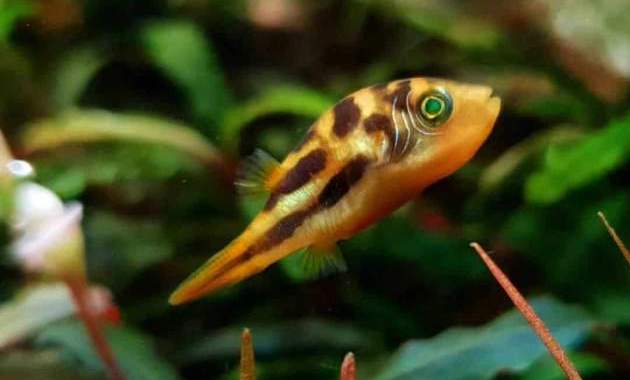
C. travancoricus have thick and solid-looking bodies. The middle parts of the body are thickest and change slightly pointed at the mouth. When reaching the dorsal fin, their body will thin out significantly. These parts turn to only about half of their maximum width and stay in the same size, whole through to the caudal peduncle.
Back to the front side, they have classic pufferfish face with a pair of huge eyes and a rectangular-shaped mouth when it opened. These small tropical fish have tiny, modest, and translucent fins. The dorsal and pectoral fins basically have the same size.
Their primary color is yellowish-green that that elongated throughout their bodies. You will see some dark/black patches on the upper side of the body with a pretty similar size, and the space between one and each other is relatively consistent. But, on the underside of the belly, these speckles are not present.
Read Also: Licorice Gourami: The Unusual Blackwater Fish
What Are The Differences Between Male And Female Dwarf Pufferfish?
Distinguishing both the sexes is relatively easy. The females have lighter yellow-white belly color, while the males’ bellies are bright yellow. The males also own a dark line on their belly, but the females don’t have.
Males usually show darker golden green in their appearance, where the females’ coloration tends to look lighter yellow-green. Another feature is wrinkles located at the around of males’ eyes. However, the dark spots on females’ bodies are tiny and random.
Read Also: 5 Effective Ways To Get Rid Of Ramshorn Snails In The Aquarium
Malabar Puffer Fish Behavior And Temperaments
The male pea puffer fish may become aggressive and territorial with other males. Sometimes, it happens with other species, but it’s rare. So, it would be best if you gave them more space to prevent it occur.
Keeping a single male with more than one female is allowed. It will drop the aggression toward the male and increase the reproduction behavior. In a large aquarium with sufficient hiding spaces, these small freshwater pufferfish regularly may be found shoaling.
They are a pretty active species. These fish are naturally easy to be curious, and hard to resist themself to uncheck out if there is something different in their tank. So, you will see them only in the specific regions but occupy all aquarium areas, including aquatic plants or open places to look for food.
You may see them investigate some fish, aquatic plants, substrates, or even the owner. Make us never feel boring when watching this little fish. They are intelligent specimens; they will beg a snack from their keeper without feeling shy when you get associated with them.
When the pea puffer engages in aggression with another one, they sometimes circle off this one by curving their tail around them. This thing is common, it’s symbolic of defense, and these spats usually happen quickly. This behavior is also present when these small freshwater fish investigate some new or unusual objects in the aquarium.
According to information from another aquarist, the Carinotetraodon travancoricus may be a fin nipper. So, do not try to keep them with some slow-swimming and long fins freshwater fish species.
Read Also: Algae Eating Fish Plecostomus in Tropical Tanks: Gold Nugget Pleco
Dwarf Pea Puffer Fish Lifespan
Generally, these smallest freshwater puffer fish have a lifespan between 4-5 years. The quality care and mix of genetics also affect their average lifespan.
If you do not serve them with the excellent quality they require, the chance to hit five years of age is impossible. But, if you follow our guide to caring for them, they may have lived longer and happily.
Read Also: How To Stop Green Dust Algae Grow In The Aquarium
Are The Dwarf Pea Puffer Fish Poisonous?
The pea puffer is probably not poisonous (there is no scientific proof until now), at least unlike their larger fugu cousins. As we know, some blowfish species can produce toxins inside their bodies, even deadly poison.
In saltwater and some brackish puffer species, this poison is called tetrodotoxin. This neurotoxin accumulates mainly in the organs while the flesh only contains a small number of poisons. While in the freshwater species, this toxin (called saxitoxin) accumulates in the flesh parts.
The toxic contents in puffer species are highly related to their diet. The poison level fluctuates throughout the years depending on the stocks of certain food types that role as its sources. Without access to the dietary sources, the poison which containing in the wild-caught puffer disappears with time.
To produce the toxic, puffer needs certain bacteria and certain types of algae that develop on the shell part of certain shellfish. Based on some information, the female fish is may be more toxic than the male because the ovaries might be able to save more poison than testes.
The pea puffer, which raised in captivity commonly are very safe and stay away from producing toxin. Most breeders usually feed them with conventional food like fish pellets or flakes and live foods such as bloodworms, so as hobbyists, do not be afraid to keep them in your tank.
Read Also: Are Axolotls Good Pets For You? It’s A Complete Guide Of Keeping, Feeding, Behavior, Characteristics
Dwarf Pea Puffer Housing & Tank Setup
These small freshwater fish can be housed in solo, small groups, or communities. The recommended tank size for a single fish is 5-gallon. The small group requires at least a 20-gallon tank size that could accommodate 4 piece pea puffer fish. It would be best if it contained one male and three females (harem). And, the communities recommended using a 40-gallon tank size.
If you would add more pygmy puffer, you should add extra 5-gallon water for each. Providing them additional spaces will give them the best habitat in the aquarium, which impacts their health and quality of life over the years.
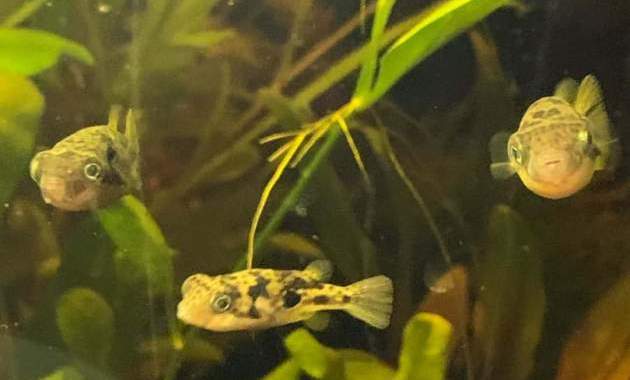
Small gravel or rough sand is more suitable for them, but there are no specific requirements for this element. You can select any type of substrate, whatever you want. Make sure the substrate you choose should highly contains rich nutrients.
These small freshwater fish species prefer an aquarium environment that resembles their natural habitat containing much vegetation. Adding dense aquarium plants will make them grow better and reduce their stress level. They are also providing plenty of dissolved oxygen for your fish.
Vigorous aquatic plants are recommended, such as Cryptocoryne x willisii, Anubias species, Java moss, etc. Covering the water surface with floating plants like Salvinia natans or Azolla cristata is also helpful. These plants offer a few shade places and help to eliminate nitrate.
Carinotetraodon travancoricus spend much time exploring by hovering above the hard surfaces than swimming in midwater in the wild. Deliberate slowly move behavior, allowing them to investigate carefully every inch of the stones, woods, roots, and plants around them. Give your dwarf puffer fish this experience by putting some decorations into your tank.
They inhabit a slow water movement in their natural habitat, so keep the water flow at a low rate. Recommended using a filter with an adjustable water outlet.
Set the lighting at the low-medium level. Puffer fish tend not to prefer a brighter condition. Make sure to select aquarium plants that thrive well in this environment.
Within your aquarium, the water temperature should be around 77-82 °F. If the temperature in your tank is fluctuating, add a heater to stable it. These fish can tolerate the water with a pH level between 6.5-8.5, but a pH level around 7.2-7.5 is ideal. Use the pH test kit to ensure it. And, the water hardness should be between 5-15 KH.
Read Also: Asian Popular Freshwater Aquarium Fish Types That Originally Live In Blackwater
How To Care For Dwarf Pea Puffer Fish
Actually, the dwarf pufferfish is not difficult to care for if you understand this species deeper. The crucial points are the water quality and tank requirements. If you pass these points, your fish pets will thrive better.
Performing water change and cleaning gravel/substrate frequently is essential. Use the gravel vacuum to clean any leftover food or feces at the bottom. Adding a garlic-infused product into the aquarium will increase your fish’s immune system and encourage feeding too.
Read Also: The Complete Guide To Keeping Sparkling Gourami Fish
Dwarf Pea Puffer Fish Tankmates
Based on their aggressive behavior, they would be best if kept in the species tank. However, small, fast-swimming fish such as Mosquito Rasbora, Glowlight Tetra, Ember Tetras, Leopard Danio, Harlequin Rasbora, Neon Tetras, and Siamese Algae Eaters and Dwarf Otocinclus can be a good choice for their tankmates.
Avoid keeping them with any larger aggressive fish such as catfish or any long-finned and slow-moving fish such as guppy and betta fish; sometimes, this puffer gets nosy by nipping other fish fins.
Never place these small predators with any freshwater shrimp and any tiny aquatic snails such as Malaysian trumpet or bladder snails; if you are, they may become a delicious snack.
Read Also: 10 Good Reason Why You Should Have An Aquarium Fish At Your Home
Dwarf Pea Puffer Fish Diet And Feeding
Although they are cute in appearance, these smallest freshwater pea puffer fish are actually carnivorous and have a pretty hefty appetite. These fish usually feed on small insects, copepods, larvae, water fleas, and microscopic algae in their natural habitat.
Within a tank, you can offer some live or frozen foods such as brine shrimp, frozen meat shrimps, bloodworms, cyclops, mosquito larvae, or snails are perfect. A conventional food like algae wafer commonly did not accept by them, but an individual is unique sometimes they may eat it.

Feeding your puffer fish twice a day in the morning and evening is excellent. Do not overfeed your fish; the uneaten food will have a destructive impact on the water quality. When it begins to decay at the bottom of the tank, it usually enhances the nitrate, which causes the algae growth.
You may need aquascaping tweezers to feed them safely or use that when planting new plants when your fish are already in the aquarium.
Read Also: The Best Aquatic Plants For Blackwater Aquarium
Breeding Dwarf Pea Puffer Fish
Breeding these smallest freshwater puffer fish in home aquaria is relatively easy. The one thing you have to do is keep the water temperature from around 79°F to 80°F. It replicates the water temperature in their natural habitat during the spawning season.
Use 5-gallon tank size for breeding place. It can accommodate one male and one female. Planting the aquarium with a dense aquatic plant is a must; adding java moss or willow moss is incredibly well-favored. Adding some bogwood is optional; if you put it there, your tank will feel more natural and provide an excellent habitat for some beneficial bacteria to grow on.
The Differentiation of the mature males is their color is brighter, while the adult female ready to spawn could be seen to their bodies become rounded as they fill with eggs.
In the courtship session, the males often chase the females around the tank until the females are ready to spawn. After that, the females will lead the males to the area with plenty of plants, and the mating begins.
Once the spawning session is complete, the males will be more aggressive by chasing away the female. Then, you should move the female into a separate tank, and the male will take responsibility to care for the eggs.
Eggs commonly hatch around 5 days, and the fry will start swimming-free for at least another week. Then, the male will lose his interest, and you can move him to other tanks. Feed the fry with live food such as artemia or micro worms. They usually reach 1 cm in body size after 2 months.
Raising the eggs and fry is difficult because they are prone to fungal infections, mainly in hard water. The aquarium must be clean, and the keepers should use an aquarium pipette to take out feces and uneaten food.
Read Also: 45 Nano Planted Tank Setup Design Inspirations To Displayed At The Office
Common Diseases That Possible Infected Pygmy Puffer Fish
According to all information that we find on the internet, these small freshwater puffer fish do not have a species-specific disease. So, nothing to worry about them. But, you might need to know some guidelines to avoid the common illness that frequently happens to tropical fish.
Like most other fresh water fish species, when the water temperature is down in the aquarium, it may cause the fish’s immune system to drop, making them prone to sickness such as ich infection (white spot disease). These conditions also occur to the pygmy puffer.
At the first time, this infection is maybe challenging to identify. You need white spot treatments available at the local fish stores or purchasing in online trades to conquer it.
Read Also: COMPLETE Blackwater Fish Tank Setup Guide
Do Dwarf Puffers Puff Up?
The answer is “Yes,” but it rarely happens. Sometimes, when you pick up your pufferfish from the aquarium, the fish may puff up their bodies to act as defensive mechanisms. They puff up by intaking water then their size body is increased. If you put them again into the aquarium and leave them alone, they will shrink back down to their standard body shape in due time.
Please do not make them stressed by making them puff up deliberately. Love your pet as your family. When you try to move them into another tank, it would be best if you use a cup or small container (not a net) to keep the fish submerged in water.

